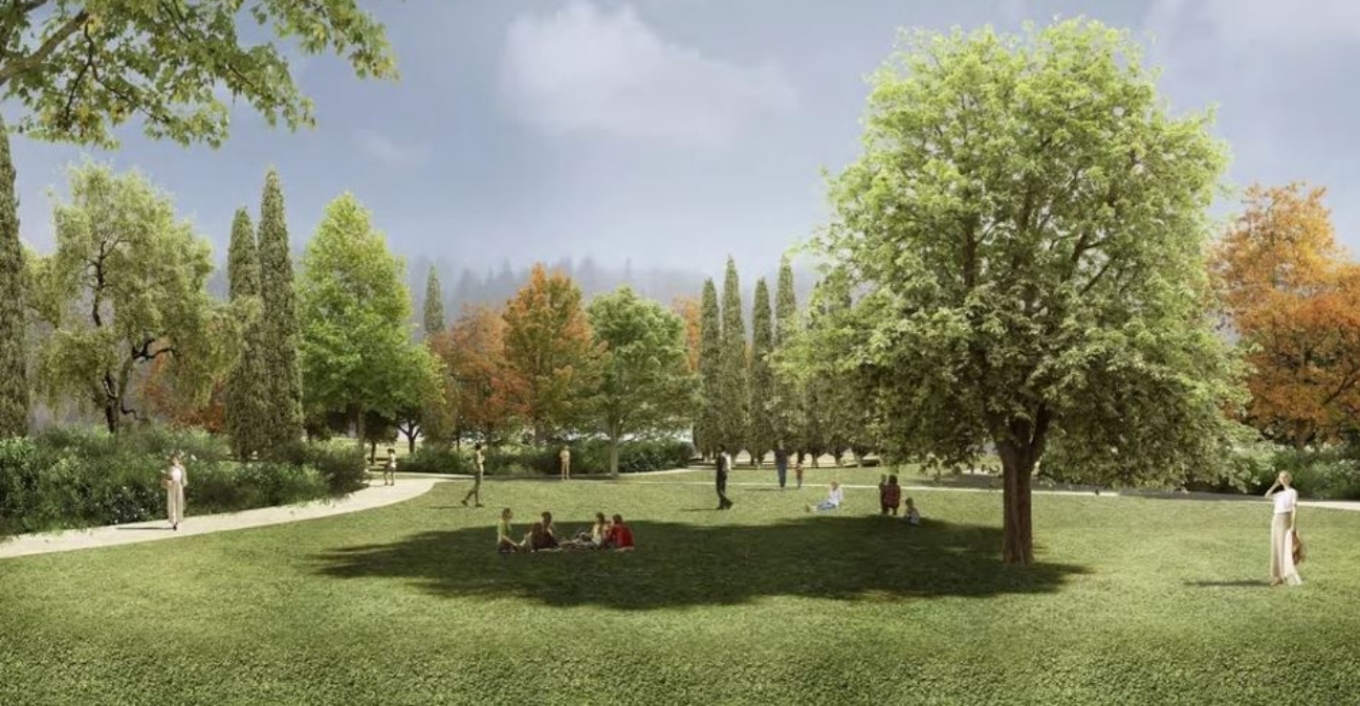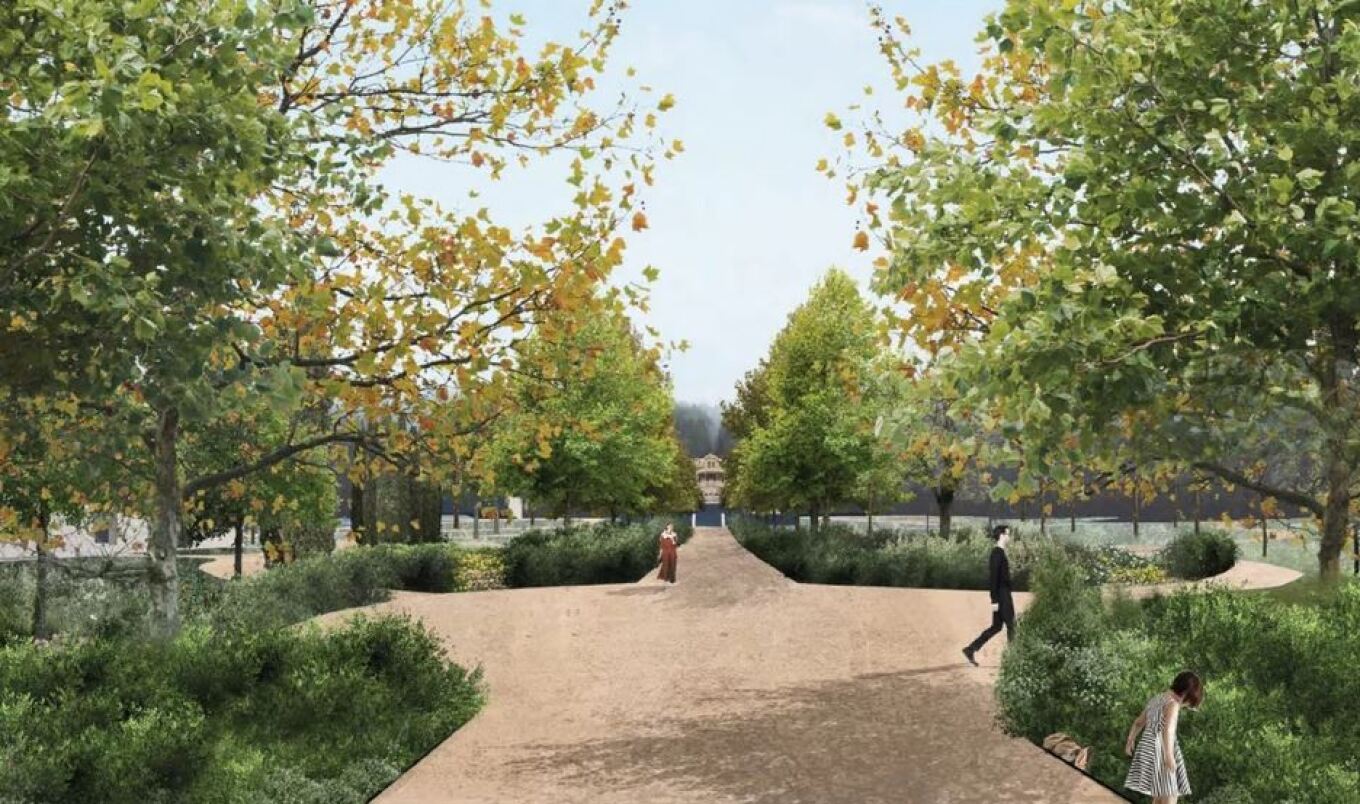
Greece’s Ministry of Culture has released new artist impressions showing what the former royal estate of Tatoi will look after it has been renovated. The revitalized estate will showcase carefully landscaped gardens, thoughtfully designed pathways, and state-of-the-art greenhouses, embodying an exquisite blend of functionality and aesthetic appeal.
In a joint press conference held today, Tuesday, January 6th, Greece’s Minister of Culture Lina Mendoni and Minister of Environment and Energy Theodoros Skylakakis presented four studies detailing restorative work scenarios for the forest landscape, the palace gardens, and the cemetery at the former royal estate of Tatoi.
Each ministry presented two studies. The Ministry of Culture is responsible for the restoration of the gardens of the palace and for the work on I.N. of the Resurrection. It will also be accountable for the Paleokastro hill cemetery within the Tatoi Estate.

The studies were carried out with the sponsorship of the Urban Non-Profit Society of Cultural and Public Benefit Project (AEGEAS), while Maria Mertzani, head of the Directorate of Conservation of Ancient and Modern Monuments, and Elli Pangalou, landscape architect and scientific associate of the Ministry of Culture, brought forward the studies for the ministry.
The Ministry of Environment and Energy has been tasked with oversight of projects related to the restoration of the forest ecosystem, as well as the restoration of vegetation and promotion of the royal cemetery.
These studies were brought forward by Evangelos Goudoufas, head of the general directorate of forests and forest environment, and Thomas Doxiadis, scientific manager of the second project.
The forest ecosystem restoration study is based on five pillars. Among these are the anti-corrosive soil protection and forest road network maintenance projects. The third includes forest fire prevention projects by creating sheltered fire protection zones and removal of logging residues.
The fourth pillar relates to the removal of standing burnt timber as a product of emergency fruiting, while the artificial reforestation on appropriately selected surfaces comprises the fifth pillar.
Due to the high risk of fires, the second study on the restoration of vegetation and development of a cemetery proposes the inclusion of a fire break zone among the new layout of vegetation in the cemetery area.
In addition, the study also calls for the restoration of the historical rows of cypress trees on the paths of the cemetery. The restoration and completion of the paths of the cemetery are also deemed essential.

Under the third study on the restoration of the palace gardens, key parameters have been identified for the design of restorations. These include historical documentation, the institutional framework for the preservation and restoration of the historic gardens, topographic features, and the use of appropriate plant material as well as sustainable materials generally.
Restorations at I.N. Resurrection and the Paleokastro hill cemetery are the focus of the fourth study. Work is moving ahead to restore the royal mausoleum, which houses the tombs of King Constantine, Sophia, and Alexander.

Along with the mausoleum, restorative work is also being carried out on the church of the resurrection, burial monuments, and basilica.
Minister of Culture Lina Mendoni said, “Restoration and regeneration projects have been systematically progressing over the last five years at the former royal estate of Tatoi within a specific schedule.
They are part of the integrated planning promoted by the government for the creation of a single and multi-thematic peri-urban green space, culture, and recreation that will fully utilize…cultural and social development potential for the benefit of the citizens of Attica and our national economy.”

Mendoni added that Tatoi has stood as “a derelict estate for decades, until recently, with a total area of 42,000 acres, consisting of a historical core of 1,600 acres and about 1,200 acres of crops. It has been protected and revived as a new pole of multiple activities of culture, historical memory, recreation, education, environmental education and knowledge.”
Building on the air of success presented by Mendoni, Minister of Environment and Energy Theodoros Skylakakis said, “With the aim of fully restoring the forest landscape in Tatoi, some of the coordinated initiatives we are implementing have already borne fruit, while at the same time we are launching a series of important, additional actions.”
Overall Plans for the Site
The overall plans for the site include the creation of museum buildings as well as leisure center facilities, although the undertaking may be challenging due to the state of the buildings after decades of abandonment and neglect.
The government is utilizing national and European resources to fund the project, which has a total budget of sixty-two million euros coming from the Recovery and Resilience Fund, the NSRF 2014-2020, the National Public Investment Program, and the Regular Budget of the Ministry of Culture.
The overall framework has thus far involved seventeen contracts and nine self-trusts, being carried out by five departments of the Ministry of Culture with a staff of ninety-three employees, concerning thirty-seven buildings of cultural significance within an area of approximately 8,500 square meters.
What is the Royal Estate of Tatoi?
The Tatoi Estate was first owned by the Greek royal family in the 1870s. Since then, it has endured numerous changes of ownership and usage following the turbulent political life of the country during the late nineteenth and the twentieth centuries.
Located on a slope of Mount Parnitha, the estate lies 27 kilometers (16 miles) from downtown Athens in an area covered by woods with rivers and abundant wildlife.
The royal estate of Tatoi also includes a large number of buildings which all served various purposes for the royal family while they resided there.
Originally designed as a summer retreat for the family, it later became the permanent residence of the Greek royals, who found its premises more private compared to the official Royal Palace in downtown Athens.
It was Greece’s King George I who originally had the idea of establishing a summer retreat for his family.
See all the latest news from Greece and the world at Greekreporter.com. Contact our newsroom to report an update or send your story, photos and videos. Follow GR on Google News and subscribe here to our daily email!



